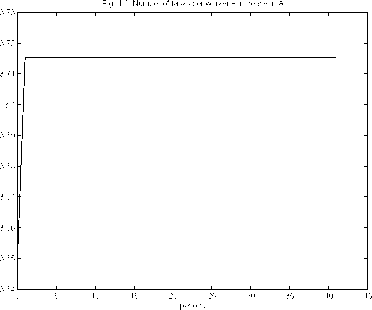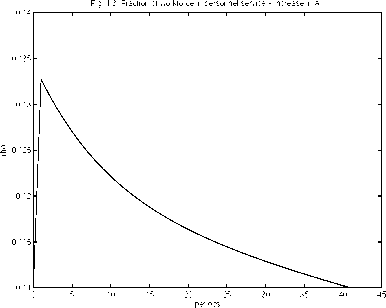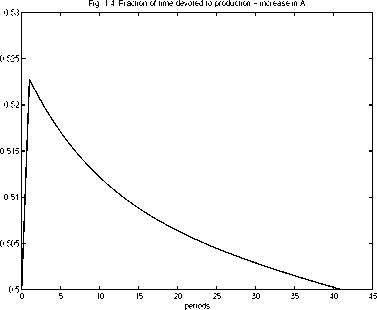The first situation considered is an increase in A (the productivity of output).
From the analytical results derived previously we know that this increase has a long
run effect on the number of tasks performed per worker and on output (that both
increase). The simulation allows studying the behaviour of all quantities also in the
short run (Figures 1.1 - 1.4).
In particular, the simulations show that the number of tasks per worker n in-
creases also in the short run, immediately after the increase in A, and remains at this
level in the long run. The output level behaves in the same way, since it increases
immediately after the increase in A, and then remains at this value in the long
run. Also the fraction of the workforce in the human resources service ρ increases
immediately after the increase in A, but then it returns to its initial level, since the
long run value of this variable is not affected by A. The same holds for the level of
human capital, that is characterized by an increase (of small amount) followed by
a decrease, and for the allocation of time between production and human capital
accumulation (with an initial increase of the time devoted to productive activity
immediately after the shock on A, that in the end returns to its initial level).


Fig. 1.2: Output - increase in A
15.71-------------------------1-------------------------1-------------------------1-------------------------1-------------------------1-------------------------1-------------------------1-------------------------1-------------------------
15.65 - -
15.6- -
15.55 - -
15.5- -
15.45 - -
15.4- -
15.35 - -
15.3 -
15.25 - -
15.2 I-------------------------1-------------------------1-------------------------1-------------------------1-------------------------1-------------------------1-------------------------1-------------------------1------------------------
0 5 10 15 20 25 30 35 40 45
periods

If we consider an increase in the parameter d that characterizes the extent of
coordination costs (a rise in d reduces the importance of coordination costs), we get
the same results as for the increase in A.
21
More intriguing information
1. Social Balance Theory2. BUSINESS SUCCESS: WHAT FACTORS REALLY MATTER?
3. A COMPARATIVE STUDY OF ALTERNATIVE ECONOMETRIC PACKAGES: AN APPLICATION TO ITALIAN DEPOSIT INTEREST RATES
4. Conditions for learning: partnerships for engaging secondary pupils with contemporary art.
5. The name is absent
6. Strategic Effects and Incentives in Multi-issue Bargaining Games
7. Integrating the Structural Auction Approach and Traditional Measures of Market Power
8. Trade Openness and Volatility
9. Experimental Evidence of Risk Aversion in Consumer Markets: The Case of Beef Tenderness
10. Multi-Agent System Interaction in Integrated SCM